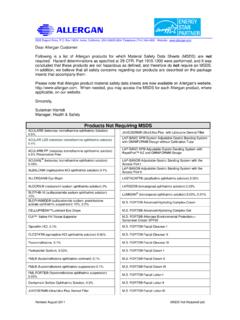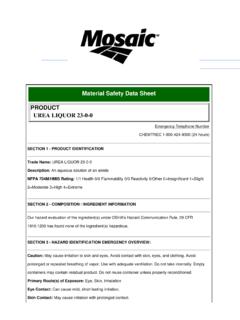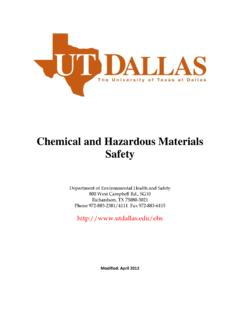Transcription of Material Safety Data Sheet
1 poloxamer 407 Pluronic F127; Polyethylene-polypropylene glycol;Polyoxyethylene-Polyoxypropylene Block Copolymer; Poly(Ethyleneoxide-co-Polypropylene oxide), Block; Block Copolymer of EthyleneOxide and Propylene Oxide; Ethylene oxide/Polypropylene oxidecopolymer; Methyl-oxirane polymer with oxiraneOxirane, methyl,-polymer with oxirane, blockPOLYMER or ( )xor HO(C2H4O)a(C3H6O)b(C2H4O)aHNot ; or 106392-12-5P1126, P1166 Not LABORATORY PRODUCTS S. SAN PEDRO STREETGARDENA, CA 90248 CALL (310) 516-8000 SPECTRUM LABORATORY PRODUCTS S.
2 SAN PEDRO STREETGARDENA, CA 90248110 Material Safety data SheetNFPAHMISP ersonal Protective EquipmentSection 1. Chemical Product and Company IdentificationCommon Name/Trade NameCatalogNumber(s).CAS#RTECSCI#Manufac turerSynonymChemical NameChemical FamilyIN CASE OF EMERGENCYCHEMTREC (24hr) 800-424-9300 Chemical FormulaSupplierSee Section Name(s)Not 8(b) inventory: CAS listed as Oxirane,methyl-, polymer with oxirane;CAS no. 106392-12-5 is notTSCA HazardFire HazardReactivityPage Number: 1 Not ) poloxamer 407, or106392-12-5100 Toxicological Dataon IngredientsNameSection and Information on IngredientsExposure LimitsTWA (mg/m3)STEL (mg/m3)CEIL (mg/m3)% by WeightCAS #Continued on Next PagePoloxamer 407 Page Number: 2 Slightly hazardous in case of skin contact (irritant), of eye contact (irritant), of ingestion, of EFFECTS: Not EFFECTS: Not EFFECTS: Not TOXICITY.
3 Not or prolonged exposure is not known to aggravate medical 3. Hazards IdentificationPotential Acute Health EffectsPotential Chronic HealthEffectsDo NOT induce vomiting unless directed to do so by medical personnel. Never give anything by mouth to anunconscious person. Loosen tight clothing such as a collar, tie, belt or waistband. Get medical attention ifsymptoms for and remove any contact lenses. In case of contact, immediately flush eyes with plenty of water for atleast 15 minutes.
4 Cold water may be used. Get medical attention if irritation with soap and water. Cover the irritated skin with an emollient. Get medical attention if irritation water may be inhaled, remove to fresh air. If not breathing, give artificial respiration. If breathing is difficult, give oxygen. Getmedical 4. First Aid MeasuresEye ContactSkin ContactSerious Skin ContactInhalationSerious InhalationIngestionSerious Ingestion>250 C (482 F)May be combustible at high products are carbon oxides (CO, CO2), CUP: >150 C (302 F).
5 Not FIRE: Use DRY chemical FIRE: Use water spray, fog or foam. Do not use water flammable to flammable in presence of in presence of of explosion of the product in presence of mechanical impact: Not of explosion of the product in presence of static discharge: Not 5. Fire and Explosion DataFlammability of the ProductAuto-Ignition TemperatureFlash PointsFlammable LimitsProducts of CombustionFire Hazards in Presence ofVarious SubstancesExplosion Hazards in Presenceof Various SubstancesFire Fighting Mediaand InstructionsSpecial Remarks onFire HazardsSpecial Remarks on ExplosionHazardsContinued on Next PagePoloxamer 407 Page Number: 3 Use appropriate tools to put the spilled solid in a convenient waste disposal container.
6 Finish cleaning byspreading water on the contaminated surface and dispose of according to local and regional a shovel to put the Material into a convenient waste disposal container. Finish cleaning by spreading wateron the contaminated surface and allow to evacuate through the sanitary 6. Accidental Release MeasuresSmall SpillLarge SpillKeep container tightly closed. Keep container in a cool, well-ventilated away from heat. Keep away from sources of ignition. Do not ingest. Do not breathe dust.
7 If ingested, seekmedical advice immediately and show the container or the 7. Handling and StoragePrecautionsStorageUse process enclosures, local exhaust ventilation, or other engineering controls to keep airborne levels belowrecommended exposure limits. If user operations generate dust, fume or mist, use ventilation to keep exposure toairborne contaminants below the exposure glasses. Lab coat. Dust respirator. Be sure to use an approved/certified respirator or equivalent. goggles.
8 Full suit. Dust respirator. Boots. Gloves. A self contained breathing apparatus should be usedto avoid inhalation of the product. Suggested protective clothing might not be sufficient; consult a specialistBEFORE handling this 8. Exposure Controls/Personal ProtectionEngineering ControlsPersonal ProtectionPersonal Protection in Case ofa Large SpillExposure LimitsNot (Granular solid. Coarse particle. Prill)Not available53 C ( F - 57 C.)Not solubility in in cold in Water: 175 g/L @ 23 deg.
9 - 14600 g/moleNot 9. Physical and Chemical PropertiesPhysical state and appearanceOdorTasteColorMolecular WeightpH (1% soln/water)Boiling PointMelting PointCritical TemperatureSpecific GravityVapor PressureVapor DensityVolatilityOdor ThresholdWater/Oil Dist. (in Water)Dispersion PropertiesSolubilityContinued on Next PagePoloxamer 407 Page Number: 4 The product is in presence of 10. Stability and Reactivity DataStabilityInstability TemperatureConditions of InstabilityIncompatibility with varioussubstancesCorrosivitySpecial Remarks onReactivitySpecial Remarks onCorrosivityPolymerizationWill not oral toxicity (LD50): 10000 mg/kg [Rat].
10 Acute dermal toxicity (LD50): >5000 mg/kg [Rabbit].Slightly hazardous in case of skin contact (irritant), of ingestion, of Dose/Conc 50% kill:LD50 [Mouse] - Route: Unreported; Dose: 2250 mg/kgAcute Potential Health Effects:Skin: Not expected to cause skin irritation. May cause skin irritation in sensitive : May cause eye : May cause respiratory tract : May cause gastric disturbances. Expected low toxicity and contain trace amounts of Ethylene oxide, and 1,4-Dioxane which may cause contain trace amounts of Ethylene oxide which may cause adverse reproductive 11.







